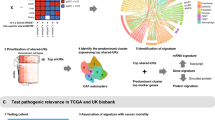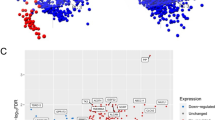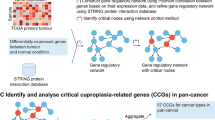Abstract
Background
Osteosarcoma (OS) is the most frequent bone tumor in children and adolescents. Tumor antigens are encoded by genes that are expressed in many types of solid tumors but are silent in normal tissues, with the exception of placenta and male germ-line cells. It has been proposed that antigen tumors are potential tumor markers.
Objectives
The premise of this study is that the identification of novel OS-associated transcripts will lead to a better understanding of the events involved in OS pathogenesis and biology.
Methods
We analyzed the expression of a panel of seven tumor antigens in OS samples to identify possible tumor markers. After selecting the tumor antigen expressed in most samples of the panel, gene expression profiling was used to identify osteosarcoma-associated molecular alterations. A microarray was employed because of its ability to accurately produce comprehensive expression profiles.
Results
PRAME was identified as the tumor antigen expressed in most OS samples; it was detected in 68% of the cases. Microarray results showed differences in expression for genes functioning in cell signaling and adhesion as well as extracellular matrix-related genes, implying that such tumors could indeed differ in regard to distinct patterns of tumorigenesis.
Conclusions
The hypothesis inferred in this study was gathered mostly from available data concerning other kinds of tumors. There is circumstantial evidence that PRAME expression might be related to distinct patterns of tumorigenesis. Further investigation is needed to validate the differential expression of genes belonging to tumorigenesis-related pathways in PRAME-positive and PRAME-negative tumors.



Similar content being viewed by others
References
Kirkin AF, Dzhandzhugazyan K, Zeuthen J. Melanoma-associated antigens recognized by cytotoxic T lymphocytes. Apmis. 1998;106:665–79.
Scanlan MJ, Gure AO, Jungbluth AA, Old LJ, Chen Y-T. Cancer/testis antigens: an expanding family of targets for cancer immunotherapy. Immunol Rev. 2002;188:22–32.
Ikeda H, Lethé B, Lehmannn F, van Baren N, Baurain JF, De Smet C. Caracterization of an antigen that is recognized on a melanoma showing partial HLA loss by CTL expressing an NK inhibitory receptor. Immunity. 1997;6:199–208.
van Baren N, Chambost H, Ferrant A, Michalex L, Ikeda II, Millard I, Olive D, Boon T, Collie PG. PRAME, a gene encoding an antigen recognized on a human melanoma by cytolytic T cells, is expressed in acute leukemia cells. Br J Haematol. 1998;102:1376–9.
Wang MG, Zakut R, Yi H, Rosenberg S, McBride OW. Localization of the MAGE1 gene encoding a human melanoma antigen to chromosome Xq28. Cytogenet Cell Genet. 1994;67(2):116–9.
Simpson AJG, Caballero OL, Jungbluth A, Chen Y-T, Old LJ. Cancer/testis antigens, gametogenesis and cancer. Nat Rev Cancer. 2005;5(8):615–25.
Epping MT, Wang L, Edel MJ, Carlee L, Hernandez M, Bernards R. The human tumor antigen PRAME is a dominant repressor of retinoic acid receptor signaling. Cell. 2005;122:835–47.
Epping MT, Bernards R. A causal role for the human tumor antigen preferentially expressed antigen of melanoma in cancer. Cancer Res. 2006;66(22):10639–42.
Altucci L, Gronemeyer H. The promise of retinoids to fight against cancer. Nat Rev Cancer. 2001;1:181–93.
Jacobs JFM, Brasseur F, Hulsbergen-van de Kaa C, van de Rakt MWMM, Figdor CG, Adema GJ, Hoogerbrugge PM, Coulie PG, de Vries IJM, et al. Cancer-germline gene expression in pediatric solid tumors using quantitative real-time PCR. Int J Cancer. 2006;120:67–74.
Jacobs JF, Grauer OM, Brasseur F, Hoogerbrugge PM, Wesseling P, Gidding CE, van de Rakt MW, Figdor CG, Coulie PG, de Vries IJ, Adema GJ. Selective cancer-germline gene expression in pediatric brain tumors. J Neurooncol. 2008;88:273–80.
Meyers PA, Gorlick R. Osteosarcoma. Pediatr Clin North Am. 1997;44:973–89.
Bielack SS, Kempf-Bielack B, Delling G, Exner GU, Flege S, Helmke K, Kotz R, Salzer-Kuntschik M, Werner M, Winkelmann W, Zoubek A, Jürgens H, Winkler K, et al. Prognostic factors in high-grade osteosarcoma of the extremities or trunk: an analysis of patients treated on Neoadjuvant Cooperative Osteosarcoma Study Group Protocols. J Clin Oncol. 1702;2002(20):776–90.
Bacci G, Bertoni F, Longhi A, Ferrari S, Forni C, Biagini R, Bacchini P, Donati D, Manfrini M, Bernini G, Lari S. Neoadjvant chemotherapy for high-grade central osteosarcoma of the extremity. Histologic response to preoperative chemotherapy correlates with histologic subtype of the tumor. Cancer. 2003;97:3068–75.
Petrilli AS, de Camargo B, Filho VO, Bruniera P, Brunetto AL, Jesus-Garcia R, Camargo OP, Pena W, Péricles P, Davi A, Prospero JD, Alves MT, Oliveira CR, Macedo CR, Mendes WL, Almeida MT, Borsato ML, dos Santos TM, Ortega J, Consentino E, Brazilian Osteosarcoma Treatment Group Studies III and IV. Results of the Brazilian Osteosarcoma Treatment Group Studies III and IV: prognostic factors and impact on survival. J Clin Oncol. 2006;24:1161–8.
Gorlick R. Osteosarcoma: clinical practice and the expanding role of biology. J Musculoskel Neuron Interact. 2002;2:549–51.
Vêncio RZ, Patrão DF, Baptista CS, Pereira CA, Zingales B. BayBoots: a model-free Bayesian tool to identify class markers from gene expression data. Genet Mol Res. 2006;5(1):138–42.
Rosenberg SA. Progress in human tumour immunology and immunotherapy. Nature. 2001;411:380–4.
De Smet C, Lurquin C, Lethe B, Martelange V, Boon T. DNA methylation is the primary silencing mechanism for a set of germ line- and tumor-specific genes with a CpG-rich promoter. Mol Cell Biol. 1999;19:7327–35.
De Smet C, De Backer O, Faraoni I, Lurquin C, Brasser F, Boon T. The activation of human gene MAGE-1 in tumor cells is correlated with genome-wide demethylation. Proc Natl Acad Sci USA. 1996;93:7149–53.
Sudo T, Kuramoto T, Komiya S, Inoune A, Itoh K. Expression of MAGE genes in osteosarcoma. J Orthop Res. 1997;15(1):128–32.
Sigalotti L, Coral S, Altomonte M, Natali L, Gaudino G, Cacciotti P, Libener R, Colizzi F, Vianale G, Martini F, Tognon M, Jungbluth A, Cebon J, Maraskovsky E, Mutti L, Maio M. Cancer testis antigens expression in mesothelioma: role of DNA methylation and bioimmunotherapeutic implications. Br J Cancer. 2002;18;86(6):979–82.
Hosomi Y, Gemma A, Hosoya Y, Nara M, Okano T, Takenaka K, Yoshimura A, Koizumi K, Shimizu K, Kudoh S. Somatic mutation of the Caspase-5 gene in human lung cancer. Int J Mol Med. 2003;12(4):443–6.
Maaser K, Borlak J, et al. A genome-wide expression analysis identifies a network of EpCAM-induced cell cycle regulators. Br J Cancer. 2008;99(10):1635–43.
Elia L, Mennuni C, Storto M, Podda S, Calvaruso F, Salucci V, Aurisicchio L, Scarito A, Ciliberto G, La Monica N, Palombo F. Genetic vaccines against Ep-CAM break tolerance to self in a limited subset of subjects: initial identification of predictive biomarkers. Eur J Immunol. 2006;36(5):1337–49.
Bauerle PA, Giris O. EpCAM (CD326) finding its role in cancer. Br J Cancer. 2007;96:417–23.
Mariani E, Meneghetti A, Tarozzi A, Cattini L, Facchini A. Interleukin-12 induces efficient lysis of natural killer-sensitive and natural killer-resistant human osteosarcoma cells: the synergistic effect of interleukin-2. Scand J Immunol. 2000;51(6):618–25.
Zhang P, Yang Y, Zweidler-McKay PA, Hughes DP. Critical role of notch signaling in osteosarcoma invasion and metastasis. Clin Cancer Res. 2008;14(10):2962–9.
Tanaka M, Setoguchi T, Hirotsu M, Gao H, Sasaki H, Matsunoshita Y, Komiya S. Inhibition of Notch pathway prevents osteosarcoma growth by cell cycle regulation. Br J Cancer. 2009;100(12):1957–65.
Meredith JE Jr, Fazeli B, Schwartz MA. The extracellular matrix as a cell survival factor. Mol Biol Cell. 1993;(9):953–61.
Acknowledgments
This work was supported by awards from the FAPESP (The State of São Paulo Research Foundation: 04/12150-8, 07/53869-3) and GRAACC (Grupo de Apoio ao Adolescente e Criança com Câncer).
Conflict of interest
The authors report no conflicts of interest. The authors alone are responsible for the content and the writing of this paper.
Author information
Authors and Affiliations
Corresponding author
Electronic supplementary material
Below is the link to the electronic supplementary material.
About this article
Cite this article
Toledo, S.R.C., Zago, M.A., Oliveira, I.D. et al. Insights on PRAME and osteosarcoma by means of gene expression profiling. J Orthop Sci 16, 458–466 (2011). https://doi.org/10.1007/s00776-011-0106-7
Received:
Accepted:
Published:
Issue Date:
DOI: https://doi.org/10.1007/s00776-011-0106-7




